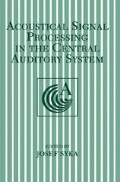Abstract
The ability to localize the source of a sound is an important function of the auditory system. It is of obvious utility for both prey and predator, as well as for social reasons, to quickly and accurately identify the locus of a sound source. Consequently, the neural mechanisms underlying sound localization have been of much interest to psychophysi- cists, anatomists and physiologists studying the auditory system. It is probably safe to say that we understand more about the central processing of sound localization cues than of any other auditory function (e.g. pitch perception, vowel discrimination)(see Irvine, 1986; Yinetal. 1997).
Access this chapter
Tax calculation will be finalised at checkout
Purchases are for personal use only
Preview
Unable to display preview. Download preview PDF.
References
Beitel. R.E. and Kaas, J.H. (1993) Effects of bilateral and unilateral ablation of auditory cortex in cats on the unconditioned head orienting response to acoustic stimuli. J. Neurophysiol. 70, 351–369.
Carlile, S. (1990) The auditory periphery of the ferret. II: The spectral transformations of the external ear and their implications for sound localization. J. Acoust. Soc. Am. 88, 2196–2204.
Casseday. J.H. and Neff. W.D. (1973) Localization of pure tones. J. Acoust. Soc. Am. 54, 365–372.
Fuchs, A.F. and Robinson, D.A. (1966) A method for measuring horizontal and vertical eye movements chronically in the monkey. J. Appl. Physiol. 21, 1068–1070.
Harris, L.A., Blakemore, C. and Donaghy, M. (1980) Integration of visual and auditory space in the mammalian superior. Nature 288, 56–59.
Heffner. R.S. and Heffner, H.E. (1982) Hearing in the elephant (Elephas maximus): Absolute sensitivity, frequency discrimination, and sound localization. J. Comp. Physiol. Psychol. 96, 926–944.
Heffner, R.S. and Heffner, H.E. (1988) Sound localization acuity in the cat: Effect of azimuth, signal duration and test procedure. Hear. Res. 36, 221–232.
Irvine, D.R.F. (1986) The auditory brainstem: processing of spectral and spatial information. Springer-Verlag, Berlin.
Jenkins, W.M. and Masterton, R.B. (1982) Sound localization: effects of unilateral lesions in central auditory sys-tem. J. Neurophysiol. 47, 987–1016.
Martin. R.L. and Webster, W.R. (1987) The auditory spatial acuity of the domestic cat in the interaural horizontal and median vertical planes. Hear. Res. 30, 239–252.
May, B.J. and Huang, A.Y. (1996) Sound localization behavior in cats: I. Localization of broadband noise. J. Acoust. Soc. Am. 100, 1059–1069.
Musicant, A.D., Chan, J.C.K. and Hind, J.E. (1990) Direction-dependent spectral properties of cat external ear: New data and cross-species comparisons. J. Acoust. Soc. Am. 87, 757–781.
Rice, J.J., May, B.J., Spirou, G.A. and Young, E.D. (1992) Pinna-based spectral cues for sound localization in cat. Hear. Res. 58, 132–152.
Thompson, G.C. and Masterton, R.B. (1978) Brain stem auditory pathways involved in reflexive head orientation to sound. J. Neurophysiol. 41, 1183–1202.
Wightman, F.L. and Kistler, DJ. (1989) Headphone simulation of free-field listening. I: Stimulus synthesis. J. Acoust. Soc. Am. 85, 858–867.
Yin, T.C.T., Joris. P.X., Smith, P.H. and Chan, J.C.K. (1997) Neuronal processing for coding interaural time dis-parities. In: Binaural and Spatial Hearing in Real and Virtual Environments, pp. 427–445. Editors: R. Gilkey and T. Anderson. Erlbaum Press, New York.
Author information
Authors and Affiliations
Editor information
Editors and Affiliations
Rights and permissions
Copyright information
© 1997 Springer Science+Business Media New York
About this chapter
Cite this chapter
Yin, T.C.T., Populin, L.C. (1997). Sound Localization and Pinna Movements in the Behaving Cat. In: Syka, J. (eds) Acoustical Signal Processing in the Central Auditory System. Springer, Boston, MA. https://doi.org/10.1007/978-1-4419-8712-9_36
Download citation
DOI: https://doi.org/10.1007/978-1-4419-8712-9_36
Publisher Name: Springer, Boston, MA
Print ISBN: 978-1-4613-4673-9
Online ISBN: 978-1-4419-8712-9
eBook Packages: Springer Book Archive

